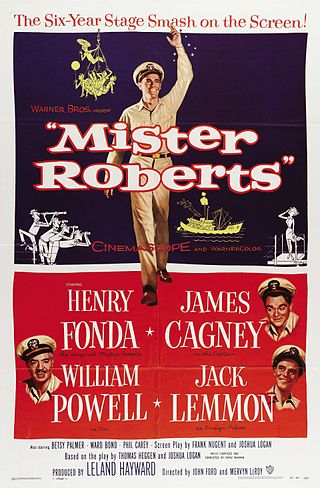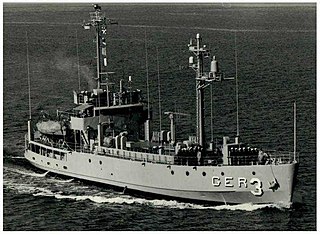Boss Radio was the name of two radio programming formats, both launched in the early 1960s: One in the United States, and one in the United Kingdom. Although the names were the same, the formats were quite different.
Swinging Radio England ("SRE") was a top 40 offshore commercial station billed as the "World's Most Powerful" that operated from 3 May 1966 to 13 November 1966 from a ship in the North Sea, four and a half miles off Frinton-on-Sea, Essex, England. While the station was dubbed a pirate radio station, its operation took place within the law and its offices were in the West End of London. Its representation was by a company formed earlier in the year to represent in Europe the ABC radio and television stations of the United States.

Technical research ships were used by the United States Navy during the 1960s to gather intelligence by monitoring, recording and analyzing wireless electronic communications of nations in various parts of the world. At the time these ships were active, the mission of the ships was covert and discussion of the true mission was prohibited. The mission of the ships was publicly given as conducting research into atmospheric and communications phenomena. Their designation was AGTR – Auxiliary, General, Technical Research – but it was more or less an open secret that this was a euphemism and they were commonly referred to as "spy ships".

Mister Roberts is a 1955 American comedy-drama film directed by John Ford and Mervyn LeRoy featuring an all-star cast including Henry Fonda as Mister Roberts, James Cagney as Captain Morton, William Powell as Doc, and Jack Lemmon as Ensign Pulver. Based on the 1946 novel and 1948 Broadway play, the film was nominated for three Academy Awards, including Best Picture, Best Sound, and Best Supporting Actor, with Lemmon winning the latter.
USS Camano (AG-130/AKL-1) was an Army Design 381 coastal freighter acquired by the United States Navy 16 July 1947 at Apra Harbor, Guam and became the lead ship of her class of cargo ship. She was configured as a Navy transport and cargo ship and operated with the U.S. Pacific Fleet until 1951, when she was turned over to the U.S. Department of the Interior.
USS Elba (AG-132/AKL-3) was a Camano-class cargo ship constructed for the U.S. Army as USA FS-267 shortly before the end of World War II and later acquired by the U.S. Navy in 1947. She was configured as a transport and cargo ship and was assigned to serve the World War II Trust Territories in the Pacific Ocean.
USS Metomkin (AG-136/AKL-7) was a Camano-class cargo ship constructed for the U.S. Army as USA FS-316 shortly before the end of World War II and later acquired by the U.S. Navy in 1947. She was configured as a transport and cargo ship and was assigned to serve the World War II Trust Territories in the Pacific Ocean.
USS Roque (AG-137/AKL-8) was a Camano-class cargo ship constructed for the U.S. Army as USA FS-347 shortly before the end of World War II and later acquired by the U.S. Navy in 1947. She was configured as a transport and cargo ship and was assigned to serve the World War II Trust Territories in the Pacific Ocean.
USS Ryer (AG-138/AKL-9) was a Camano-class cargo ship constructed for the U.S. Army as the Freight and Supply Ship USA FS-361 shortly before the end of World War II. On delivery the ship was U.S. Coast Guard crewed and assigned to serve the Southwest Pacific area during the war. The ship was acquired by the U.S. Navy in 1947, configured as a transport and cargo ship, named and was Commissioned, Miscellaneous Auxiliary, USS Ryer (AG-138), 8 June 1947 and reclassified Light Cargo Ship, (AKL-9), 31 March 1949.

USS Sharps (AG-139/AKL-10) was a Camano-class cargo ship constructed for the U.S. Army as USA FS-385 shortly before the end of World War II and later acquired by the U.S. Navy in 1947. She was configured as a transport and cargo ship and was assigned to serve the World War II Trust Territories in the Pacific Ocean. She later served with distinction in the Korean War.

USS Hewell (AG-145/AKL-14) was a Camano-class cargo ship constructed for the U.S. Army as FS-391 shortly before the end of World War II. FS-391 operated with a U.S. Coast Guard crew in the Southwest Pacific area. The ship was acquired by the U.S. Navy in 1948. She was configured as a transport and cargo ship and served with the U.S. Pacific Fleet – including highly decorated service during the Korean War – until decommissioned in 1955.
USS Mark (AG-143), was built as the Aircraft Repair variant, Design 427, of the Army FS types as FS-214 for use by the United States Army. She was built at Higgins Industries, New Orleans, Louisiana, completed in December 1944. The ship was designed with the well deck covered to provide shop space for the work of repairing aircraft by an embarked Aircraft Maintenance Unit (Floating).

USNS New Bedford (FS-289/AKL-17) was a Navy owned Military Sea Transportation Service civilian crewed Camano-class cargo ship originally constructed for the U.S. Army as the coastal freighter FS-289 shortly before the end of World War II.

The USS Banner was originally U.S. Army FS-345 serving in the Southwest Pacific during the closing days of World War II as one of the Army's United States Coast Guard crewed ships. In 1950 the ship was acquired by the Navy and converted into a light auxiliary cargo (AKL). In 1967 the ship was converted for electronic intelligence and reclassified as Auxiliary General Environmental Research (AGER).

USS Palm Beach (AGER-3) was a former Army Auxiliary Aircraft Repair Ship converted to an electronic and signals intelligence ship of the United States Navy.

The Banner class was a class of three environmental research ships converted from Camano-class cargo ships by the United States Navy during the 1960s. The class comprised three ships: Banner, Pueblo, and Palm Beach. The ships were originally United States Army vessels, which had been built in 1944. Although officially classified as environmental research ships, they were actually used for signals intelligence gathering, as part of the AGER program.
USS Torry (AKL-11) was a Camano-class cargo ship of the United States Navy. During World War II, she previously served as the United States Army Transport FS-394. After being acquired by the United States Navy, the ship was commissioned as USS Torry (AG-140), but was later reclassified as a light cargo ship. On 29 January 1952, she was transferred to the Department of the Interior and was sold to Socony-Mobil in 1961. The ship was successively sold to several companies before becoming a fishing vessel and was scuttled in 2015 off the coast of Delaware as an artificial reef.

USS Brule (AKL-28) was a U.S. Army Design 381-A Coastal Freighter of the United States Navy and later the South Korean Navy that saw service during World War II, the Korean War, and the Vietnam War.

NOAAS George B. Kelez, previously NOAAS George B. Kelez, was an American research vessel in commission in the National Oceanic and Atmospheric Administration (NOAA) fleet from 1972 to 1980. Prior to her NOAA career, she operated under the United States Fish and Wildlife Service′s Bureau of Commercial Fisheries from 1962 to 1970 as US FWS George B. Kelez and the National Marine Fisheries Service from 1970 to 1972 as NOAAS George B. Kelez.

Alhena (AKL-38) was a Design 381 built for the United States Army as FS-257. The Army vessel was U.S. Coast Guard crewed, serving in the Southwest Pacific during World War II.











